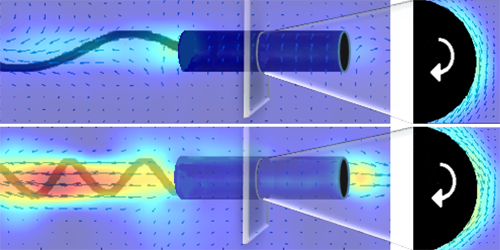How Microswimmers Push Through Solid-Like Fluids
We all feel like we’re forcing our way through mud sometimes, but for some creatures, that’s reality. Many microorganisms move in fluids that behave like solids until forced to flow by stresses imposed by the microorganism’s swimming motion. Now in an experiment that mimics a helical bacteria swimming in mucus, Hadi Mohammadigoushki of Florida State University and his colleagues pinpoint two critical thresholds that a swimmer must overcome to propel itself in these yield-stress fluids [1].
The team made a 3D-printed corkscrew-shaped model of a bacteria, placed it in a high-viscosity polymer gel, and caused it to rotate using a magnetic field. Then, with particle tracking and imaging techniques, the researchers measured the swimmer’s speed and visualized the flow field around it. Their experiments revealed that first the swimmer must overcome the fluid’s yield strain to be able to rotate. Then the fluid’s yield stress must be sufficiently low that a large volume of fluid gets set into motion around the swimmer. Both conditions only result in movement if the tail propulsion is strong enough to deform the fluid around the swimmer; if the tail propulsion is too weak, the swimmer remains stuck in the fluid. Finally, once locomotion is underway, the pitch of the swimmer’s corkscrew-shaped tail determines how fast movement proceeds.
The understanding could help to predict how Helicobacter pylori corkscrewing through gastric mucus causes ulcers, how earthworms burrowing in the ground enhance soil aeration, and how parasites eating through fruit infect crops. The experimental approach could also allow further investigation of problems of organism motility and material design in biology, health, and agriculture that have until now only been accessible through theory.
–Rachel Berkowitz
Rachel Berkowitz is a Corresponding Editor for Physics Magazine based in Vancouver, Canada.
References
- F. Nazari et al., “Helical locomotion in yield stress fluids,” Phys. Rev. Lett. 130, 114002 (2023).




